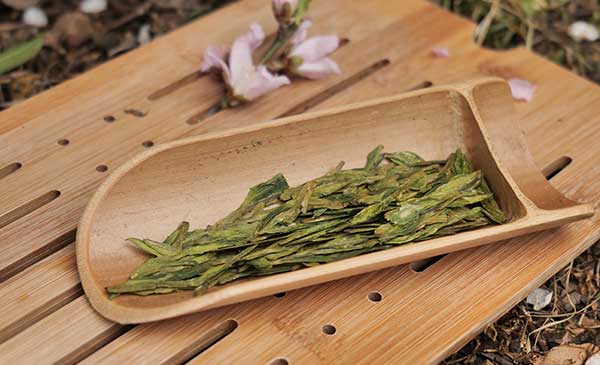What is Longjing Tea: The Legendary Dragonwell

When it comes to iconic Chinese teas, Longjing tea (also known as Dragonwell tea) stands at the top of the list. Revered for centuries for its smooth taste, beautiful flat leaves, and rich cultural heritage, Longjing is not just a tea—it's an experience.
Whether you're a seasoned tea drinker or just dipping your toes into the world of premium loose-leaf teas, learning about Dragonwell Longjing opens the door to one of China’s most prestigious tea traditions.
Discover everything you need to know about Longjing tea. We'll explore its origins, processing, flavor profile, how to brew it properly. Find out why Dragonwell Long jing is so celebrated.
What is Longjing Tea?
Longjing translates to “Dragon Well,” and refers both to a type of green tea and to the region near Hangzhou, Zhejiang Province in eastern China where it has been cultivated for over a thousand years. The name comes from a legendary well in the village of Longjing, where folklore and tea culture intertwine.
Long jing dragon well is considered a pan-fired green tea, meaning the tea leaves are roasted by hand in a hot wok during processing. This roasting method halts oxidation, preserving the tea's green color and vegetal freshness, but also giving it its signature toasty, nutty flavor.

Dragonwell Longjing: The Most Famous Longjing Tea
“Dragonwell” is the English translation of “Longjing,” but when people say “Dragonwell Longjing,” they are usually referring to the highest grade Longjing tea, produced from the original core growing areas in Hangzhou, especially around West Lake (Xihu).
This area, with its misty hills, mineral-rich soil, and centuries-old tea traditions, is recognized by the Chinese government as the official origin of authentic Dragonwell tea. In fact, Xihu Longjing has been granted protected designation of origin (PDO) status—like Champagne in France or Parmigiano-Reggiano in Italy.
The History of Longjing Tea
Longjing tea has been cherished since the Tang Dynasty (618–907 CE) but rose to national fame during the Song Dynasty (960–1279 CE). It was during the Qing Dynasty, under the reign of Emperor Qianlong (1711–1799), that Longjing received its most illustrious endorsement.
According to legend, Qianlong visited the Longjing village and was so impressed by the tea that he designated 18 Longjing tea bushes near the Hugong Temple as imperial tea trees. These trees are still alive today and are highly protected national treasures.
Because of its long royal association, Longjing has earned the title of “Imperial Tea” and is often given as a diplomatic gift.
Where is Longjing Tea Grown?
While the most prized Longjing comes from West Lake (Xihu) in Hangzhou, there are also reputable Longjing teas produced in surrounding areas of Zhejiang Province.
Each subregion has its own microclimate and unique flavor expression. Teas from West Lake are typically more expensive and have a more refined flavor, while teas from other areas may be more affordable but still offer excellent quality.
How is Longjing Tea Made?
Longjing tea is known for its meticulous handcrafted processing. Here's how it's typically made:
1. Plucking
Harvesting is done by hand, usually picking one bud and one or two tender leaves. The early spring harvest, especially pre-Qingming (before April 5), is the most prized for its delicate flavor.
2. Withering
Freshly picked leaves are spread out and left to wither in the shade, reducing moisture and preparing them for firing.
3. Pan-Firing (Sha Qing)
This is the signature step that sets Longjing apart. The leaves are pan-fired in large, shallow woks to stop oxidation. The skillful hand movements during pan-firing shape the leaves into their iconic flat, spear-like form.
4. Shaping and Drying
The tea master continues pressing, tossing, and folding the leaves until they are perfectly flat and dry, preserving their jade-green hue and layered flavor.
The Taste of Longjing Tea
Longjing tea is prized for its smooth, refreshing taste and subtle complexity. Tasting notes often include:
- Toasted chestnut
- Grassy sweetness
- Orchid or floral hints
- Umami
- Creamy texture
The flavor can vary depending on where it’s grown and when it’s harvested. Early spring Dragonwell tends to be lighter, sweeter, and more delicate, while later harvests may be bolder or more vegetal.
The aroma is fresh and green, often described as “bean-like” or “toasty,” and the liquor is a clear pale green or yellowish color.

How to Brew Longjing Tea
Longjing tea is delicate and requires some attention to bring out its best flavor. Here's how to brew it properly:
What You Need:
- High-quality Longjing loose-leaf tea
- Glass or porcelain cup or gaiwan
- Water temperature: 160–185°F (70–85°C)
- Steeping time: 1–3 minutes
Brewing Steps:
- Warm your vessel with hot water, then discard the water.
- Add about 1 teaspoon (2g) of Longjing loose leaf tea per 8 oz of water.
- Pour the water along the wall of the cup or teapot to avoid shocking the leaves.
- Let steep for about 1–2 minutes for the first infusion.
- Enjoy up to 3–4 steeps, increasing time slightly with each infusion.
Tip: Glass cups or teapots let you enjoy the beautiful leaf dance as the flat leaves float and then gently sink.
How to Tell If It’s Authentic Dragonwell
With Longjing’s popularity, there are many counterfeits or lower-quality knockoffs on the market. Authentic Dragonwell leaves will be flat, smooth, and spear-shaped with a light green color and occasional white fuzz.
The tea should have a fresh, slightly nutty aroma and a clean, smooth, umami flavor.
Health Benefits of Longjing Tea
Like other green teas, Longjing is rich in antioxidants and nutrients that support overall wellness:
- Catechins and polyphenols: Help fight free radicals and support cell health.
- L-theanine: Promotes calm focus without the jitters.
- Vitamins C and E: Naturally found in the leaves.
- Low caffeine: About 15–30 mg per cup, offering a gentle energy lift.
Drinking Longjing regularly may support metabolism, heart health, and mental clarity—all while giving you a luxurious sensory experience.
Culinary Uses of Longjing Tea
Beyond brewing, Longjing tea is sometimes used in Chinese cuisine. One famous dish is Dragonwell Shrimp. Fresh river shrimp are stir-fried with a sauce infused with steeped Longjing tea and a few tea leaves. The dish is light, aromatic, and showcases how the tea's essence pairs with food.
Why Longjing is a Cultural Icon
Longjing isn’t just a tea; it’s a symbol of Chinese elegance and refinement. It has inspired poets, emperors, and scholars for centuries. Offering Longjing to guests is a gesture of hospitality and respect.
For tea enthusiasts, owning a good Dragonwell is akin to a wine lover having a treasured bottle of vintage Bordeaux.
Final Thoughts: A Cup of History and Elegance
Longjing tea offers more than a drink—it’s a gateway to Chinese heritage, artisan tea craftsmanship, and the serene pleasure of slowing down. With its chestnut-sweet notes and silky texture, it’s no wonder Longjing has been loved by emperors and tea lovers for generations.
Whether you’re new to green tea or looking to explore the finest loose-leaf offerings, Dragonwell Longjing deserves a place in your cup.






